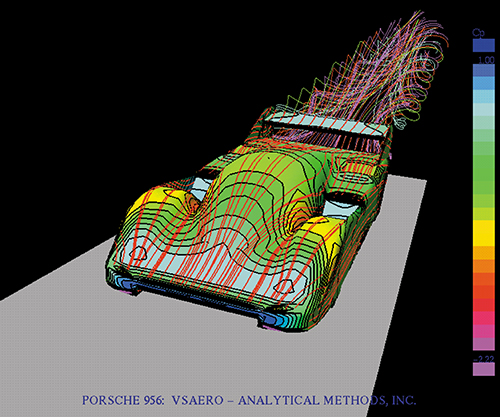Go With the Flow
Through work beginning in the 1970s with NASA's Ames Research Center, Analytical Methods, Inc. (AMI), began developing a technology that has evolved into the innovative computational fluid dynamics (CFD) analysis method called VSAERO. The focus of the NASA research was to provide advanced tools to predict the low-speed, or subsonic, aerodynamics of aircraft for the purpose of reducing the risks involved in flight and minimizing the cost and time to develop advanced aircraft.
Researchers create mathematical models of flight vehicles and "fly" them by computer simulation. This permits study of the performance and behavior of many different designs before settling on a final configuration. This technique of computational simulation has expanded in recent years to develop visual imagery of many types of forces acting upon a flight vehicle, including phenomena that cannot be cost effectively simulated in wind tunnels. AMI has advanced this type of research into a commercial product that helps aircraft, marine craft, and rotorcraft makers, among others, predict and understand the physics behind a vehicle's motion. VSAERO stems from an effort to realize a major goal in aeronautical science: the ability to routinely simulate complex three-dimension fluid flow around a complete airplane and understand its propulsion systems. Such a capability has allowed the solution of many problems and made possible many of the computations required to develop advanced vehicles with greater reliability and performance.
VSAERO has been used in a number of unique designs. Skipper Dennis Conners used VSAERO to design the hull of his ship, Stars and Stripes, which went on to win the America's Cup in 1986. VSAERO has also been used in the design of innovative solar automobiles, such as the award-winning Sunraycer solar automobile, as well as solar airplanes. With more conventional uses, VSAERO can image aerodynamic flows around a complete Boeing 727 in just five minutes! The ability to calculate internal and external flows and body rotation makes VSAERO applicable to fluid flow problems in aerospace, aeronautical, automotive, and marine engineering.
VSAERO also has special-purpose modules that expand the software's simulation capabilities to include effects of flow on interactions between a helicopter's rotor and fuselage. Other modules help the user design simulations involving complex geometric models of structures and wake analysis.
AMI was incorporated in 1971 to conduct research and development in aerodynamics and hydrodynamics for government and industry. Since then, AMI has developed a series of CFD packages and has provided consultation services using company and third-party applications software. AMI offers design and analysis services in addition to software development. Company engineers have experience in all aspects of internal and external aerodynamics and hydrodynamics. AMI provides design, wind tunnel, and flight-testing services. AMI customers include the international aerospace, automotive, and marine industries.
VSAEROTM is a trademark of Analytical Methods, Inc.

AMI’s VSAERO™ can calculate internal and external body flows, making the software ideal for automobile design.













